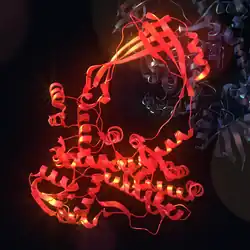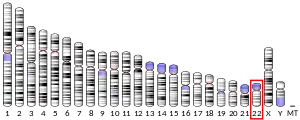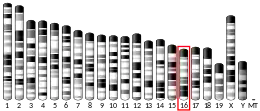TOP3B
DNA topoisomerase 3-beta-1 is an enzyme that in humans is encoded by the TOP3B gene.[5][6][7]
| TOP3B | |||||||||||||||||||||||||||||||||||||||||||||||||||
|---|---|---|---|---|---|---|---|---|---|---|---|---|---|---|---|---|---|---|---|---|---|---|---|---|---|---|---|---|---|---|---|---|---|---|---|---|---|---|---|---|---|---|---|---|---|---|---|---|---|---|---|
 | |||||||||||||||||||||||||||||||||||||||||||||||||||
| Identifiers | |||||||||||||||||||||||||||||||||||||||||||||||||||
| Aliases | TOP3B, TOP3B1, topoisomerase (DNA) III beta, DNA topoisomerase III beta | ||||||||||||||||||||||||||||||||||||||||||||||||||
| External IDs | OMIM: 603582 MGI: 1333803 HomoloGene: 2923 GeneCards: TOP3B | ||||||||||||||||||||||||||||||||||||||||||||||||||
| |||||||||||||||||||||||||||||||||||||||||||||||||||
| |||||||||||||||||||||||||||||||||||||||||||||||||||
| |||||||||||||||||||||||||||||||||||||||||||||||||||
| |||||||||||||||||||||||||||||||||||||||||||||||||||
| |||||||||||||||||||||||||||||||||||||||||||||||||||
| Wikidata | |||||||||||||||||||||||||||||||||||||||||||||||||||
| |||||||||||||||||||||||||||||||||||||||||||||||||||
This gene encodes a DNA topoisomerase, an enzyme that controls and alters the topologic states of DNA during transcription. This enzyme catalyzes the transient breaking and rejoining of a single strand of DNA which allows the strands to pass through one another, thus relaxing the supercoils and altering the topology of DNA. The enzyme interacts with DNA helicase SGS1 and plays a role in DNA recombination, cellular aging and maintenance of genome stability. Alternative splicing of the C-terminus of this gene results in three transcript variants which have distinct tissue specificity; however, not all variants have been fully described.[7]
References
- GRCh38: Ensembl release 89: ENSG00000100038 - Ensembl, May 2017
- GRCm38: Ensembl release 89: ENSMUSG00000022779 - Ensembl, May 2017
- "Human PubMed Reference:". National Center for Biotechnology Information, U.S. National Library of Medicine.
- "Mouse PubMed Reference:". National Center for Biotechnology Information, U.S. National Library of Medicine.
- Tang D, Kidd VJ (Dec 1998). "Cleavage of DFF-45/ICAD by multiple caspases is essential for its function during apoptosis". J Biol Chem. 273 (44): 28549–52. doi:10.1074/jbc.273.44.28549. PMID 9786842.
- Kawasaki K, Minoshima S, Nakato E, Shibuya K, Shintani A, Schmeits JL, Wang J, Shimizu N (May 1997). "One-megabase sequence analysis of the human immunoglobulin lambda gene locus". Genome Res. 7 (3): 250–61. doi:10.1101/gr.7.3.250. PMID 9074928.
- "Entrez Gene: TOP3B topoisomerase (DNA) III beta".
Further reading
- Andersson B, Wentland MA, Ricafrente JY, et al. (1996). "A "double adaptor" method for improved shotgun library construction". Anal. Biochem. 236 (1): 107–13. doi:10.1006/abio.1996.0138. PMID 8619474.
- Yu W, Andersson B, Worley KC, et al. (1997). "Large-scale concatenation cDNA sequencing". Genome Res. 7 (4): 353–8. doi:10.1101/gr.7.4.353. PMC 139146. PMID 9110174.
- Seki T, Seki M, Onodera R, et al. (1998). "Cloning of cDNA encoding a novel mouse DNA topoisomerase III (Topo IIIbeta) possessing negatively supercoiled DNA relaxing activity, whose message is highly expressed in the testis". J. Biol. Chem. 273 (44): 28553–6. doi:10.1074/jbc.273.44.28553. PMID 9786843.
- Ng SW, Liu Y, Hasselblatt KT, et al. (1999). "A new human topoisomerase III that interacts with SGS1 protein". Nucleic Acids Res. 27 (4): 993–1000. doi:10.1093/nar/27.4.993. PMC 148278. PMID 9927731.
- Shimamoto A, Nishikawa K, Kitao S, Furuichi Y (2000). "Human RecQ5beta, a large isomer of RecQ5 DNA helicase, localizes in the nucleoplasm and interacts with topoisomerases 3alpha and 3beta". Nucleic Acids Res. 28 (7): 1647–55. doi:10.1093/nar/28.7.1647. PMC 102787. PMID 10710432.
- Kobayashi M, Hanai R (2001). "M phase-specific association of human topoisomerase IIIbeta with chromosomes". Biochem. Biophys. Res. Commun. 287 (1): 282–7. doi:10.1006/bbrc.2001.5580. PMID 11549288.
- Strausberg RL, Feingold EA, Grouse LH, et al. (2003). "Generation and initial analysis of more than 15,000 full-length human and mouse cDNA sequences". Proc. Natl. Acad. Sci. U.S.A. 99 (26): 16899–903. Bibcode:2002PNAS...9916899M. doi:10.1073/pnas.242603899. PMC 139241. PMID 12477932.
- Ota T, Suzuki Y, Nishikawa T, et al. (2004). "Complete sequencing and characterization of 21,243 full-length human cDNAs". Nat. Genet. 36 (1): 40–5. doi:10.1038/ng1285. PMID 14702039.
- Lehner B, Sanderson CM (2004). "A protein interaction framework for human mRNA degradation". Genome Res. 14 (7): 1315–23. doi:10.1101/gr.2122004. PMC 442147. PMID 15231747.
- Cho YH, Park JY, Han SY, Chung IK (2004). "Identification of the functional elements in the promoter region of human DNA topoisomerase IIIbeta gene". Biochim. Biophys. Acta. 1679 (3): 272–8. doi:10.1016/j.bbaexp.2004.08.001. PMID 15358519.
- Collins JE, Wright CL, Edwards CA, et al. (2005). "A genome annotation-driven approach to cloning the human ORFeome". Genome Biol. 5 (10): R84. doi:10.1186/gb-2004-5-10-r84. PMC 545604. PMID 15461802.
- Gerhard DS, Wagner L, Feingold EA, et al. (2004). "The status, quality, and expansion of the NIH full-length cDNA project: the Mammalian Gene Collection (MGC)". Genome Res. 14 (10B): 2121–7. doi:10.1101/gr.2596504. PMC 528928. PMID 15489334.
- Rual JF, Venkatesan K, Hao T, et al. (2005). "Towards a proteome-scale map of the human protein-protein interaction network". Nature. 437 (7062): 1173–8. Bibcode:2005Natur.437.1173R. doi:10.1038/nature04209. PMID 16189514. S2CID 4427026.
This article is issued from Wikipedia. The text is licensed under Creative Commons - Attribution - Sharealike. Additional terms may apply for the media files.



